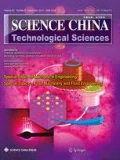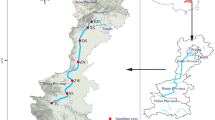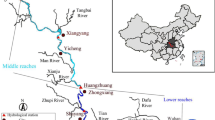Abstract
Water release operation is crucial for water quality in large reservoirs such as Three Gorges Reservoir (TGR), because it determines the hydrodynamics and hence the self-purification capability. As algal blooms were often observed in some tributary bays of TGR during the release periods, high frequency field observations were carried out in a typical eutrophic tributary bay (Xiangxi River) from February 9 to May 10, 2009. In this paper we assess the hydrodynamic behaviour, density stratification, and trophic status in this bay, respectively using a series of observations for flow, physical, chemical and biological parameters. Then, we analyze the effects of reservoir release operations on algal blooms using correlation analysis method. An empirical prognosis is concluded for the likelihood of algal bloom occurrence as a function of daily fluctuation of water level (DFWL) and water temperature. Our results indicate that during the release period, the algal bloom occurrences are closely tied to the DFWL in that if the ratio of DFWL to total water depth ranges from −10×10−4 to 0, the possibility of algal blooms may reach up to 70%, and if the ratio is less than −10×10−4, then that risk can be significantly reduced to less than 10%. This paper finally suggests that a wave-type water release operation should be beneficial in reducing bloom frequencies in the tributary water bodies, which is helpful for TGR water quality management, especially for the water release operation optimization.
Similar content being viewed by others
References
Reynolds C S. The Ecology of Freshwater Phytoplankton. London: Cambridge University Press, 1984
Solis M, Poniewozik M, Mencfel R. Bloom-forming cyanobacteria and other algae in selected anthropogenic reservoirs of the Łęczna-Włodawa Lakeland. Int J Oceanol Hydrobiol, 2009, XXXVIII(S2): 71–78
Leeuwangh P, Kappers F I, Dekker M, et al. Toxicity of cyanobacteria in Dutch lakes and reservoirs. Aquatic Toxic, 1983, 4(1): 63–72
Skulberg O M, Codd G A, Carmichael W W. Toxic blue-green algal blooms in Europe: a growing problem. Ambio, 1984, 13: 244–247
Carmichael W W, Jones C L A, Mahmood N A, et al. Algal toxins and water-based diseases. CRC Crit Rev Environ Control, 1985, 15: 275–313
Berg K, Soli N E. Toxicity studies with the blue-green algal Oscillaioria agardhii from two eutrophic Norwegian lakes. Acta Velerinaria Scandinavica, 1985, 26: 363–373
Aniderson D M, Glibert P M, Burkholder J M. Harmful algal blooms and eutrophication: nutrient sources, composition, and consequences. Estuaries, 2002, 25(4b): 704–726
Wang F E, Lv H C, Chen Y X, et al. Analysis of the spatial and temporal changes in chlorophyll a concentration in Qiandao Lake and its impact factors. J Zhejiang U (Agricul & Life Sci), 2004, 30(1): 22–26
Vavilin V A. Evaluation of the chlorophyll concentration to predict the trophic state of lakes. Hydrol Sci, 1979, 24: 225–228
Dawson E Y. Marine Botany, an Introduction. New York: Holt, Rinehart and Winston, 1966
Boney A D. A Biology of Marine Algae. London: Hutchinson Educational Ltd, 1965. 216
Prescott G W. The Algae: A Review. Boston: Houghton Mifflin, 1968
Round F E. The Biology of Algae. New York: St. Martin’s Press, 1973
OECD. Eutrophication of Waters. Monit, Assess, Contr, 1982
Demeke K, Amha B. Seasonal variation in phytoplankton primary production in relation to light and nutrients in Lake Awasa. Ethiopia Hydrobiologia, 1990, 196: 217–227
Luigi N F. Phytoplankton assemblages in twenty-one Sicilian reservoirs: Relationships between species composition and environmental factors. Hydrobiologia, 2000, 424: 1–11
Gome L C, Miranda L E. Hydrologic and climatic regimes limit phytoplankton biomass in reservoirs of the Upper Paraná River Basin, Brazil. Hydrobiologia, 2001, 457: 205–214
Peter S, Jan E V, Jeroen K, et al. The effect of atmospheric carbon dioxide elevation on plant growth in freshwater ecosystems. Ecosystem, 2004, 7(1): 63–74
Sakamoto M. Primary production by phytoplankton community in some Japanese lakes and its dependence on lake depth. Arch Hydrobiol, 1966, 62: 1–28
Dillon P J, Rigler F H. The phosphorus-chlorophyll relationship in lakes. Limnol Oceanogr, 1974, 19(5): 767–773
Brown C D, Hoyer M V, Bachmann R W, et al. Nutrient-chlorophyll relationships: an evaluation of empirical nutrient-chlorophyll models using Florida and northern temperate lake data. Can J Fish Aquat Sci, 2000, 57: 1574–1583
Hoyer M V, Frazer T K, Notestein S K, et al. Nutrient, chlorophyll, and water clarity relationships in Florida’s nearshore coastal waters with comparisons to freshwater lakes. Can J Fish Aquat Sci, 2002, 59: 1024–1031
Fang T, Fu C Y, Ao H, et al. The comparison of phosphorus and nitrogen pollution status of he Xiangxi Bay before and after the impoundment of the Three Gorges reservoir. Acta Hydrobiologica Sinica, 2006, 30(1): 26–30
Kuang Q J, Bi Y H, Zhou G J, et al. Study on the phytoplankton in the Three Gorges Reservoir before and after sluice and the protection of water quality. Acta Hydrobiologica Sinica, 2005, 29(4): 353–358
Su Y M, Ji D B, Liu D F. Nutrients dynamics in Xiangxi Bay during the impounding of Three Gorges Reservoir. Rev Sci & Tech, 2008, 26(17): 62–69
Yang Z J, Liu D F, Ji D B, et al. Influence of the impounding process of the Three Gorges Reservoir up to water level 172.5 m on water eutrophication in the Xiangxi Bay. Sci China, 2010, 53(4): 1114–1125
Dai H C, Cao G J, Su H Z. Management and construction of the Three Gorges Project. J Constr Eng Manag, 2006, 132(6): 615–619
Changjiang Water Conservancy Commission (CWCC). Study on Comprehensive Utilization and Reservoir Dispatching of Three Gorges Project. Wuhan: Hubei Science and Technique Press, 1997
Li J X, Liao W G. Control indexes for comprehensive prevention of eutrophication. Water Resource Protection, 2002, 2: 4–5
Li W. Development of Environmental Hydraulics. Wuhan: Wuhan Hydraulic and Electric Engineering Press, 1999
Ye L, Han X Q, Xu Y Y, et al. Spatial analysis for spring bloom and nutrient limitation in Xiangxi Bay of Three Gorges Reservoir. Environ Monit Assess, 2007, 127: 135–147
Fang Z Y. Environmental and ecological issues of Three Gorges Project//Proceedings of China Yangtze Three Gorges Project, for 2000 ICOLD 68th Annual Meeting & 20th Congress. Beijing: China Water Power Press, 2000. 162–167
Chen Y B, Pan D Z. Environmental control and management on Three Gorges Project construction. Water Power, 2000, 6: 69–71
Cai Q H, Hu Z Y. Studies on eutrophication problem and control strategy in the Three Gorges Reservoir (in Chinese). Acta Hydrobiol Sin, 2006, 30(1): 7–11
Janik J J, Taylor W D, Barko J W. A Compilation of Common Algal Control and Management Techniques. Technical Report #E-80-1, US Army Engineer Waterways Experiment Station, Vicksburg, MS, 1980
Jin L. Environmental Ecology. Beijing: Higher Education Press, 1992
Qin B Q, Yang L Y, Chen F Z. Mechanism and control of lake eutrophication. Chin Sci Bull, 2006, 51(19); 2401–2412
Cao G J, Chen Y B. Water environment actuality and protected countermeasures of Three Gorges Reservoir (in Chinese). Sci Tech Rev, 2005, 23(10): 25–29
Yi Z Q, Liu D F, Yang Z J, et al. Water temperature structure and impact of which on the bloom in spring in Xiangxi Bay at Three Gorges Reservoir. J Hydrol, 2009, 2(5): 6–11
Soulsby R L. Selecting record length and digitization rate for near-bed turbulence measurements. J Phys Oceanogr, 1980, 10(2): 208–219
Voulgaris G, Trowbridge J H. Evaluation of the acoustic Doppler velocimeter (ADV) for turbulence measurements. J Atmos Oceanic Tech, 1998, 15(1): 272–289
State Environmental Protection Administration (SEPA). Monitoring Analysis Method for Water and Wastewater. Beijing: China Environmental Science Press, 2005
Huang X F, Chen W M, Cai Q M. Observation and Analysis Research for Lake Ecology. Beijing: China Standard Press, 2000
Xu H X. On the variation of water temperature in Meishan reservoir. Oceanologia et Limnologia Sinica, 1964, 6(2): 135–151
Ji D B, Liu D F, Yang Z J, et al. Hydrodynamic characteristics of Xiangxi Bay in Three Gorges Reservoir. Sci China, 2010, 40(1): 101–112
Wang L L, Dai H C, Cai Q H. Numerical predicting of velocity and Chl. a in Xiangxi River and correlativity research. J Basic Sci Eng, 2009, 17(5): 652–658
Thomann R V, Mueller J A. Principles of Surface Water Quality Modeling and Control. New York: Harper & Row, 1987
Jin X C, Tu Q Y. Investigation Criterion of Lake Eutrophication. Beijing: Chinese Environment Science Press, 1999
Jin X C. Chinese Lakes and Environments. Beijing: Ocean Press, 1995
Liu Y M, Jia S F, Jiang L W. A study on the impact of the Three Gorges Reservoir on potential eutrophication in backwaters of tributaries of Chongqing section of Yangtze River. Geogr Res, 2003, 22(1): 67–72
Lawson R, Anderson M A. Stratification and mixing in Lake Elsinore, California: An assessment of axial flow pumps for improving water quality in a shallow eutrophic lake. Water Res, 2007, 41(19): 4457–4467
Padisák J, Barbosa F, Koschel R, et al. Deep layer cyanoprokaryota maxima in temperate and tropical lakes. Arch Hydrobiol Spec Issues Advanc Limnol, 2003, 58: 175–199
Schindler D W. Evolution of phosphorus limitation in lakes. Science, 1977, 195: 260–262
Klausmeier C A, Litchman E, Daufresne T, et al. Optimal nitrogen-to-phosphorus stoichiometry of phytoplankton. Nature, 2004, 429: 171–174
Smith V H. The nitrogen and phosphorus dependence of algal biomass in lakes: an empirical and theoretical analysis. Limnol Oceanogr, 1982, 27(6): 1101–1112
Odum H T. Systems Ecology: An Introduction. New York: A Wiley-Interscience Publication, 1983
Chiaudani G, Premazzi G. Appraisal of the Possible Methods of Combatting the Threat of Eutrophication in Community Waters. Brussels: Commission of the European Community, 1988
Carbiener R. État actuel des connectivités entre le Rhin et sa bande riveraine. Actes du séminaire Gestion et restauration des milieux fluviaux, Mulhouse, 1992
Kong F G, Gao G. Hypothesis on cyanobacteria bloom-forming mechanism in large shallow eutrophic lakes. Acta Ecologica Sinica, 2005, 25(3): 581–595
Wang L L, Dai H C, Cai Q H. Numerical simulation of the ecological operation schedule in Xiangxi River. J Huazhong Univ Sci Tech, 2009, 37(4): 111–114
Ren J H. Tide-type irrigation of water and nutrient. Water Saving Irrigation, 2004, 3: 49–50
Yang T S. Tide-type irrigation on the ground. Agricul Eng Tech, 2009, 4: 23–24
Author information
Authors and Affiliations
Corresponding author
Rights and permissions
About this article
Cite this article
Zheng, T., Mao, J., Dai, H. et al. Impacts of water release operations on algal blooms in a tributary bay of Three Gorges Reservoir. Sci. China Technol. Sci. 54, 1588–1598 (2011). https://doi.org/10.1007/s11431-011-4371-7
Received:
Accepted:
Published:
Issue Date:
DOI: https://doi.org/10.1007/s11431-011-4371-7




